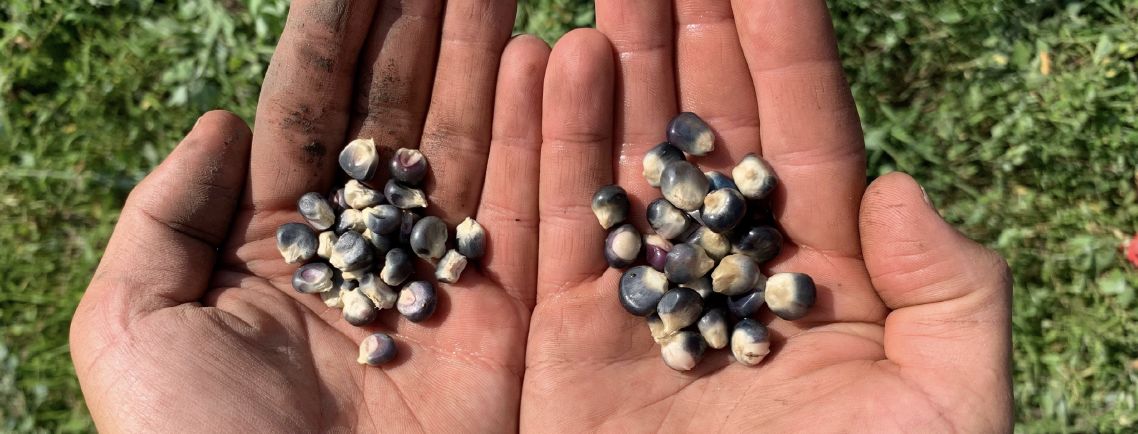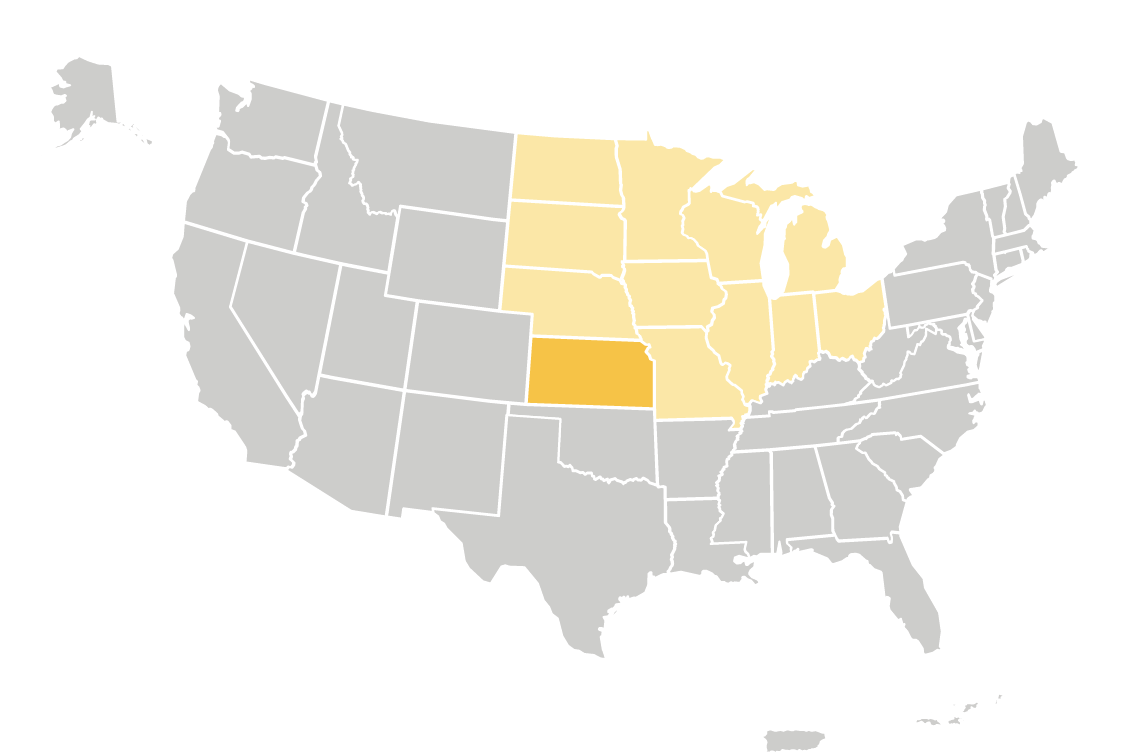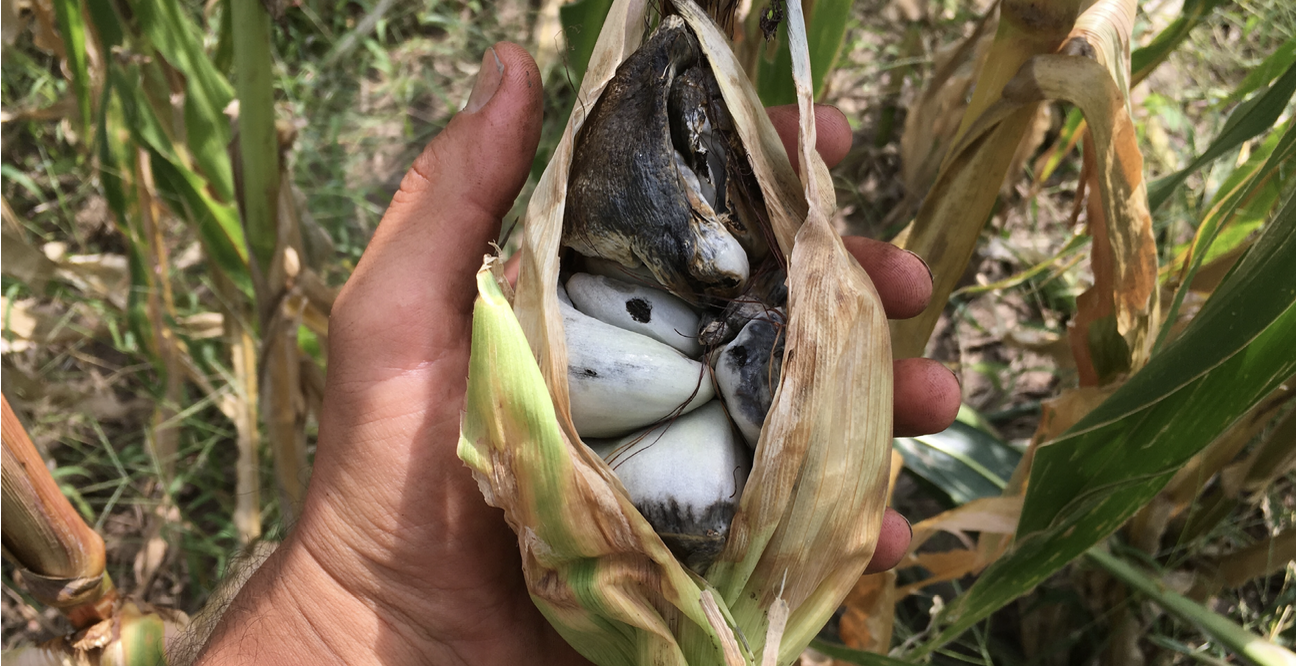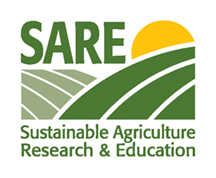
Mexica farming methods for ancestral corn reclaim indigenous knowledge, nurture belonging and community for Latino/a and diaspora communities, and contribute to farmers’ higher yield and reduced inputs.
Growing lesser-known Mexica food products such as maize, pipiche, papalotl, jicama, and mexican mint marigold has created a deeper sense of community between myself and local Latino/a communities here in Kansas, too. Latino/a farmers market customers, restaurant owners, cooks, and grocers have seen more of what ancestral crops are possible to produce here in Northeast Kansas through this research and through my operation, Maseualkualli Farms. The rewarding feeling of nurturing culture away from its ancestral points of origin goes beyond description and is personally one of the biggest positive outcomes of this study.”
—Pantaleon Florez III, Farmer/Rancher Grantee
Ancestral Crops Nurture Belonging for Latino/a Diaspora

Region: North Central
State: Kansas
Grant Type: Farmer/Rancher
Grant: FNC19-1161
SARE POST-PROJECT EVALUATION IMPACT MODEL
This evaluation impact model is specific to this SARE-funded project.
Sustainability Impacts
The project grantees and stakeholders contributed to the following sustainability impacts:
- Environmental sustainability impacts
- Economic sustainability impacts
- Production efficiency impacts
- Social sustainability impacts
Grantee Indicators
(Farmer/Rancher)
Project grantees (defined above) achieved sustainability impacts by engaging with the following indicators through involvement with project activities:
- Increased knowledge/skills
- Increased capacity/motivation
- Increased engagement
- Practice change
- Career growth
Stakeholder Indicators
(Co-Researcher/Student Interns, Farmers)
Project stakeholders (defined above) achieved sustainability impacts by engaging with the following indicators through involvement with project activities:
- Increased knowledge/skills
- Increased engagement
- Practice change
- Career growth
The Success Story
Before receiving a SARE producer grant, Pantaleon Florez III, Founder and Owner of Maseualkualli Farms in Kansas, was struck by the lack of access to diverse, nutrient-dense varieties of corn in his area. His only option was driving a half hour to a market selling Mexica and Latino/a foods, and even there the corn options were limited, and he did not know the origins or history of the corn he was buying. This inspired him to work with seed banks, such as the North Central Regional Plant Introduction Station’s Germplasm Resources Information Network, to access corn seeds from Guanajuato, Mexico, where his great-grandfather is from, and additional Mexica seeds. The SARE producer grant helped fund Florez III’s first full season as a farmer, giving him the financial stability needed to get his farming operation off the ground. Florez III’s success is due in part to using the indigenous knowledge of maize planting methods he learned from the Florentine Codex, an authoritative account of Nahua (Aztec) life, written shortly after Spanish conquistadors landed at Veracruz. With SARE funding, Florez III was able to complete a comparative yield analysis between Florentine Codex methods and current no-till best practices for growing three types of ancestral maize. Florez III hired two University of Kansas undergraduate students who participated as co-researchers and fellow ethnographers. For two of the three types of corn in this study, the Mexica hilling method contributed to a statistically significant higher yield of maize. This project reclaimed Mexica seeds, valued indigenous knowledge, and fostered a sense of community amongst the researchers involved and the wider Latino/a diaspora in Kansas. Through social media and community presentations and meals, this project improved market visibility and market opportunities for non-genetically modified, heirloom dent corn production and improved culturally relevant food access. Since the end of the grant, Florez III has expanded his operation to growing five different crops, and in 2023 he had the biggest harvest of corn to date, producing enough corn to sell in his community, in addition to opening conversations to sell Hirsuta peanuts to a local doughnut shop.
Ancestors as Partners in the Research
With the husk facing outward I looked at the inward facing side; it was open and huitacoche was looking back at me. I froze; thawed only by the rush of emotion that swiftly followed. The ancestors had sent a gift. I felt gratitude. A comforting and cool breeze picked up. My heart was open, and I felt closer to my ancestors. I felt deeply validated in my research, a deep sense of purpose. This is the work I am supposed to be doing. Tlazocamti Cinteotl, Tlaloc, Quezalxochitl. Tlazocamati Ometeotl."
—Pantaleon Florez III, Farmer/Rancher Grantee
Grantee (Farmer/Rancher) Highlights

Florez III utilized SARE funds to hire two undergraduate students who had not farmed before, but who had the more important openness to learning that Florez III was looking for in co-researchers. He benefited professionally and personally from the shared learning and mentoring within his research team. Prior to the SARE funding award, Florez III was trained in ethnography, and he utilized this methodology to report about his learning process. In contrast to European science approaches, ethnography provided a freer, exploratory form of storytelling informed by “a more indigenous science kind of way.” Each member of the research team shared their respective stories and learning journeys through ethnographic narrative and photography in the final grantee report. For Florez III, the SARE project provided an opportunity to explore his innovative farming interests systematically and scientifically, while further defining his niche in agriculture as he expanded his role as a fruit and veggie farmer to becoming a seed breeder and agroecologist.
Florez III appreciates that SARE producer grants are accessible, noting how this kind of introductory grant has helped producers like himself develop grant writing and management skills—skills he continues to use daily. Currently, Florez III works as an Experiential Learning Specialist coordinating the district-wide Farm to School and Work-Based Learning programs. In this role he collaborates with food services, curriculum, and HR wellness teams. The research skills he honed as a SARE grantee have helped him create and deliver professional development to Farm to School Garden Coordinators at 21 school sites. Florez is also one of 13 members of the first cohort of the Racial Equity Learning Lab that launched in fall 2023. The Lab, a partnership between the National Farm to School Network and USDA, draws on the narratives and experiences of cohort members to build a shared understanding of racial inequities in the food system and to advance racial equity within the Farm to School movement. Building on his SARE experience, Florez III hopes his involvement in the Lab will lead to more Farm to School work-based learning opportunities for BIPOC students to enter agriculture and research. Further, Florez III is developing Black, Indigenous, People of Color (BIPOC)-led “Food as a Public Work” in Douglas County and beyond, which seeks to move from current consumptive food security models to productive ones that provide well-paid, government funded agricultural jobs designed to focus solely on producing to feed people in need.
Pantaleon, Ashley, and the ancient alien crop of corn reminded me of the resilience, ingenuity, pragmatic genius, and artistic excellence of my ancestors. That continues to be a flame of pride that no doubt makes me a more multidimensional, spiritual, and embodied human."
—Paola Ramírez Peña, Co-researcher and Student Intern
Positive, Long-Term Impact of Reconnecting with Ancestors
Other Stakeholder (Co-Researchers/Student Interns, Farmers) Highlights
The two undergraduate interns and co-researchers, Ashley Aranda and Paola Ramírez Peña, valued the mentorship they received, the farming skills they developed as beginning farmers, and the ways that Florez III situated their work within wider food systems. Through ethnographic narrative and photography, Ramírez Peña and Arranda described project impacts such as deepening connections with their ancestors and cultural stewardship, improved physical and emotional health, and a sense of belonging, community, and wholeness.
When asked to comment on the impact of their involvement from project start through present day, Ramírez Peña noted that Florez III provided “an exceptional example of equitable leadership” by paying a fair wage for their time, labor and expertise, demonstrating “generosity and “a clear vision of the future”, and setting an example for respectful work relationships. The experiential learning that Ramirez Peña gained on the farm was a welcome shift from the traditional teaching models in formal college classrooms. Because of the experience and skills gained working on the farm, Ramirez Peña went on to be hired as an Intern at the Douglas County Sustainability Office internship and then as a Urban Sustainability Directors Network fellow. Ramirez Peña now works as a youth voice educator and a Strategic Partnerships Manager at a nonprofit in the Bay Area.
In addition, this SARE project benefited other beginning farmers at the incubator farm where Maseualkaulli Farms is based through the purchase of a shared wheel hoe specifically for corn. The wider community also benefited from the efforts of the research team to engage the public in learning about ancestral corn, Mexica farming methods, and the nixtamalization process that makes maize bioavailable to the human body. More than 700 people were reached through social media outlets, presentations, farmers markets, and via local community meals utilizing the corn grown for this study.
SARE Guides Beginning Farmers Towards Partnerships as Key to Farming Success
As a beginner farmer there is pressure to do everything yourself. You don't have money for help; you're not integrated into anyone's chain. ... SARE guides you in the direction of building partnerships; you need more than just yourself. That siloed farmer is the one in a lot of trouble. The high suicide rate amongst farmers is because a lot of us feel we are in a system that pushes us to think we have to have bootstraps to pick ourselves up by when actually you need a whole system of people. The SARE grant process helps you figure out those partnerships and how everything is connected. One result is you're able to get your product and your culture to a much wider audience through that gentle nudge [from SARE] to think about the social and economic components.”
—Pantaleon Florez III, Farmer/Rancher Grantee
Sustainability Impacts
Florez III sees the primary achievement of his SARE project as a social act of “reclamation”. In reconnecting with the seeds from his “ancestral homeland in Mexico and growing them on his Kansas-based farm, reclamation recognizes the role that ancestors and mentors have played in stewarding maize and other crops for thousands of years. It shifts the mainstream narrative in the sustainable agriculture community that often devalues corn as bad for the environment due to use of synthetic pesticides and as lacking nutritional value. Florez III’s SARE project demonstrates that growing corn does not negatively impact the environment if you “treat it right and breed it for the right purposes”. There is great potential for reintroducing ancestral varieties of corn that are highly nutritious and that have unique, overlooked, and symbiotic relationships with bacteria that benefit the corn and the ecosystem at large. Notably, the Mexica corn varieties Florez III is growing nurture bacteria that fix nitrogen from the atmosphere and feed it directly to the corn plant, reducing the need for synthetic nitrogen fertilizers. Growing corn in this way moves beyond “breeding corn just for ourselves” to breeding plants that benefit local ecology. This dislodges the colonial concept that “the edge of my farm is the edge of my responsibility” and shifts toward farmers being responsible for interrelated plants, land, and other life forms. Lastly, reclamation involves the hard work of reclaiming indigenous knowledge that has been systematically eradicated by centuries of colonialism. By seeking out an ancient codex for his SARE research, Florez III elevates the resilience and relevance of indigenous ways and situates his work in the notion that innovation “doesn’t mean that future developments are always the best thing. Sometimes we have to go back in time and reclaim some of the systems we threw away.”
This corn variety I am growing will create a gel on the aerial roots, which attracts bacteria that eat nitrogen out of the atmosphere and feed it directly to the plant. You don't see this symbiotic relationship between corn and bacteria on synthetic pesticide-ready corn because it was bred out; no one was breeding it for the purpsoe of maintaining a symbiotic relationship. As a farmer, using these ancestral corn varieties means less inputs. With bacteria that feed your corn nitrogen, you don't have to add as much synthetic nitrogen. The bacteria can account for between 30 and 70 percent of your corn nitrogen needs. ... I don't buy inputs and I don't have to worry about the nitrogen leaking out into our watershed”
—Pantaleon Florez III, Farmer/Rancher Grantee
Growing Ancestral Corn Involves Less Inputs and Reduced Nitrogen Leakage

Barriers
Florez III noted that many of the ancient manuscripts he sought were either written by Spaniards recording indigenous knowledge through their colonial lens and/or by indigenous people who were writing/ illustrating under extreme oppression. As such, seeking out ancestral indigenous knowledge was a painful, challenging process. At the same time, ethnographic research provided a pathway for Florez III and his two co-researchers to engage in a process of healing, gratitude, and cultural stewardship. For example, each researcher highlighted their own account of finding and cooking huitlacoche—a dark fungi that grows off the corn and is considered a sacred delicacy—in a collective act of storytelling, nourishment, and celebration amidst adversity. Additional challenges included market access as a beginning farmer and consumers not understanding the nutritious value of what they might see as “ornamental” corn. In response, Florez III educated consumers on how to safely process and cook corn and worked in local kitchens and other parts of the food chain to better understand the links between farmers and consumers. Florez III also faced weather events that led to flooding of one of the sample sites and had limited access to land, as his farm is only one acre. Looking ahead, Florez III is thinking about scalability by partnering with a farmer who has more acreage as well as partnerships with companies that can process his corn harvest into end products that build a supply chain and further improve food access for the community.
Acknowledgements
This research study took place on Kaw and Osage Lands. More must be done to protect, bolster, and foster indigenous sovereignty. Special thanks to my elders and ancestors for being stewards of land and culture. I am ever thankful for these deep connections, and I hold a deep respect for the 10,000 years of maize cultivation leading to this very day. Tlazocamati Cinteotl, Tlaloc, Quetzalxochitl. Tlazocamati Ometeotl. ”
—Pantaleon Florez III, Farmer/Rancher Grantee

